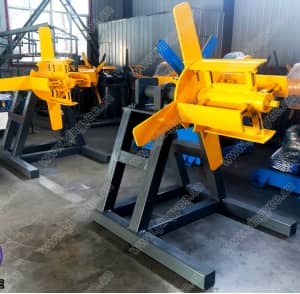
The Evolution and Application of Stud Roll Forming Machines
The construction and manufacturing industries are constantly evolving, and with that evolution comes the need for tools and machinery that can improve efficiency, precision, and cost-effectiveness. Among these innovations, the stud roll forming machine stands out as a crucial piece of equipment for producing high-quality metal studs and tracks, widely used in lightweight steel framing systems. This article will explore the workings, advantages, and applications of stud roll forming machines, shedding light on their significance in modern construction.
Understanding Stud Roll Forming Machines
Stud roll forming machines are specialized machines that continuously transform flat metal sheets or coils into specific profiles. The process begins with the uncoiling of metal sheets, typically made of galvanized steel or other suitable materials. The metal is then fed through a series of rollers, each designed to progressively shape the material into the desired stud profile. This process is known as cold roll forming, which involves bending the metal without the application of heat.
The key components of a stud roll forming machine include the entry section, roll stands, cutting section, and hydraulic systems. The entry section ensures a smooth feeding of the metal sheet, while the roll stands contain multiple sets of rollers that progressively shape the metal. After reaching the desired shape, the product is cut to length using a hydraulic cutting mechanism, ensuring precise dimensions with minimal waste.
Advantages of Using Stud Roll Forming Machines
Stud roll forming machines offer numerous advantages that make them an essential investment for manufacturers and builders. Here are some key benefits
1. High Efficiency The continuous nature of the roll forming process allows for rapid production rates. Machines can produce thousands of studs per hour, significantly reducing manufacturing time compared to traditional methods.
2. Consistency and Precision The automated nature of roll forming ensures uniformity in the product. Each metal stud produced maintains consistent dimensions and quality, reducing the need for extensive quality control checks.
3. Material Savings The roll forming process is design with minimal material waste in mind. Manufacturers can optimize material usage, leading to cost savings and reduced environmental impact.

4. Versatility Stud roll forming machines can be easily adjusted to produce various stud sizes and shapes, allowing manufacturers to cater to diverse project needs. This flexibility is vital in meeting specific client requirements.
5. Enhanced Strength The cold-forming process used in stud roll forming enhances the mechanical properties of the metal, producing stronger and more durable studs that can withstand various environmental conditions.
Applications in the Construction Industry
The versatility and efficiency of stud roll forming machines have led to their widespread application in the construction industry. Some common applications include
- Framing Systems Metal studs are a popular choice for constructing interior walls and partitions. Their lightweight nature, combined with high strength, makes them ideal for both residential and commercial projects.
- Ceiling Grid Systems Stud roll forming machines produce metal channels and sections that are essential for creating grid systems that support acoustic ceilings.
- Curtain Wall Systems In commercial buildings, metal studs are used in curtain wall systems, which allow for large windows and glass facades, enhancing the aesthetic appeal while providing structural support.
- Prefabricated Housing The precision and efficiency of stud roll forming enable the creation of prefabricated walls and building components, streamlining the construction process and reducing labor costs.
Conclusion
In summary, stud roll forming machines have revolutionized the way metal studs and tracks are manufactured in the construction industry. Their efficiency, precision, and versatility make them indispensable tools for builders and manufacturers looking to optimize their operations. As the demand for lightweight steel framing continues to grow, the role of stud roll forming machines will likely expand, paving the way for more innovative construction solutions. Embracing this technology not only enhances productivity but also contributes to sustainable building practices, making it an essential consideration for the future of construction.